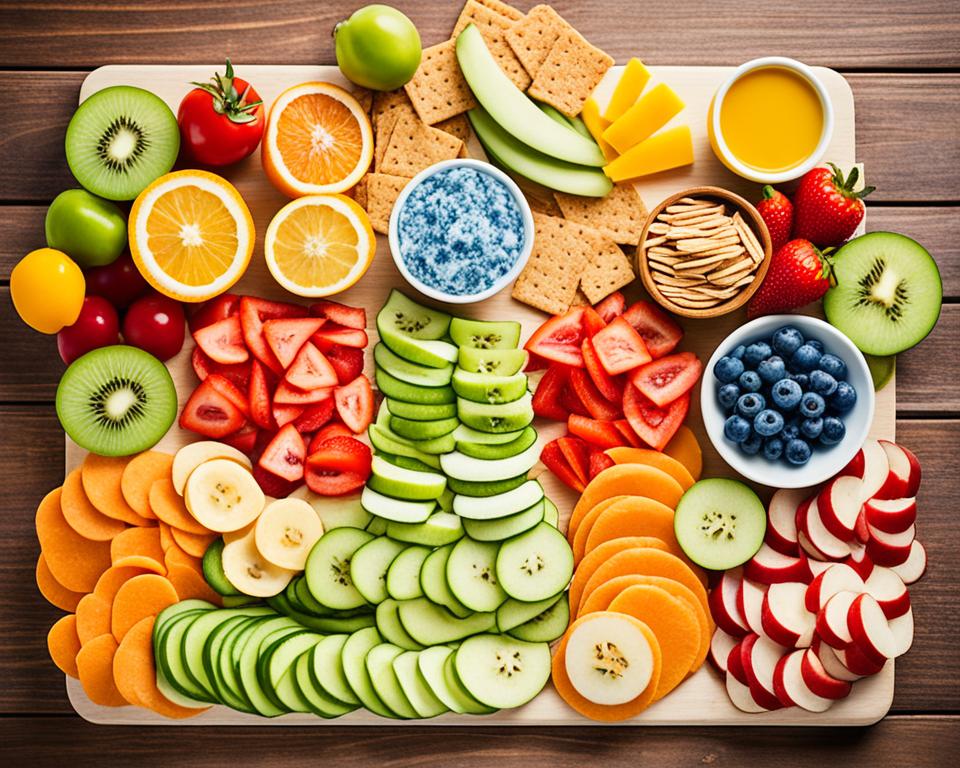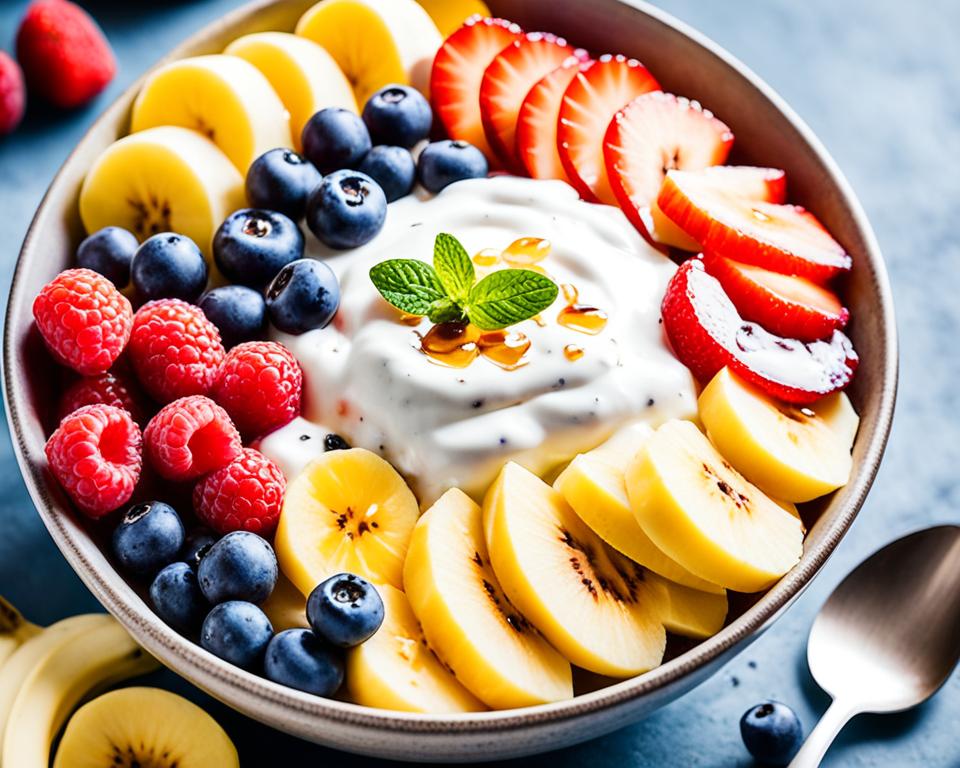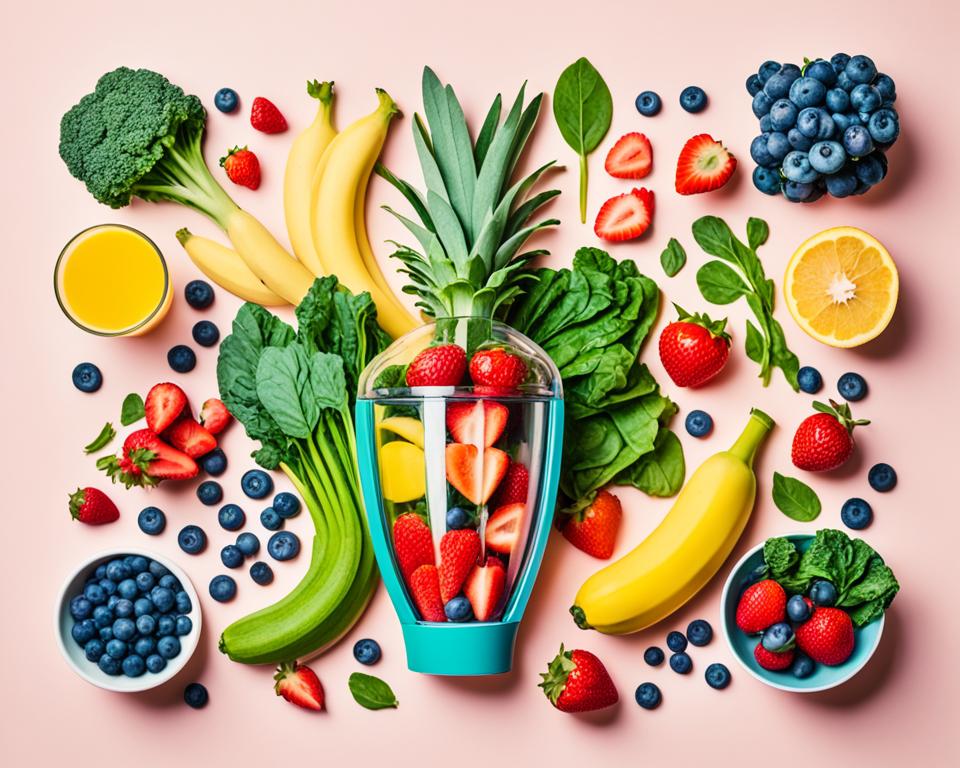Kids love snacks, but finding healthy options can be challenging. Offering sugar-free snacks is a great way to provide nutritious and delicious options that kids will love.
Key Takeaways:
- Providing sugar-free snacks for kids ensures they get the nutrition they need without excessive sugar consumption.
- Sugar-free snacks help prevent tooth decay and promote healthy teeth and gums.
- There are plenty of tasty and nutritious snack ideas for kids, such as sliced pears with ricotta cheese and peanut butter dip with apples or celery.
- Ready-made and packaged snacks like olives, freeze-dried fruits and veggies, and popcorn are convenient and sugar-free options for kids.
- Establishing snack rules and involving kids in grocery shopping can encourage healthy snacking habits and expand their food preferences.
Why Choose Sugar-Free Snacks for Children?
Sugar-free snacks are an excellent choice for children as they offer numerous benefits for their overall health and well-being. By opting for sugar-free snacks, parents can provide their little ones with wholesome and nutritious options that will support their growth and development.
One of the key advantages of sugar-free snacks is their ability to prevent tooth decay and promote healthy teeth and gums. Excessive sugar consumption can lead to cavities and other dental issues, but by opting for sugar-free alternatives, parents can help protect their children’s oral health.
Furthermore, sugar-free snacks are packed with essential vitamins and nutrients that are vital for children’s growth. These snacks provide a well-rounded source of energy, supporting their daily activities and promoting healthy bodily functions.
Choosing sugar-free snacks for children also helps in instilling good eating habits from an early age. By introducing them to healthier options, parents can help children develop a preference for nutritious snacks and minimize their cravings for sugary treats.
To illustrate the importance of sugar-free snacks for children, here is a comparative table highlighting the benefits:
| Benefits | Sugar-Free Snacks | Sugary Snacks |
|---|---|---|
| Prevents tooth decay | Yes | No |
| Promotes healthy teeth and gums | Yes | No |
| Provides essential vitamins and nutrients | Yes | No |
| Supports overall growth and development | Yes | No |
| Develops a preference for healthy snacks | Yes | No |
As you can see from the table, sugar-free snacks offer a range of benefits that can positively impact a child’s health and well-being. By making conscious choices when it comes to their snacks, parents can set their children on the path to a lifetime of healthy eating habits.
Choosing sugar-free snacks for children is an investment in their long-term health and well-being. By prioritizing nutritious options and minimizing their intake of sugary treats, parents can ensure that their children are getting the nutrition they need without compromising on taste or enjoyment.
Healthy Snack Ideas for Kids
When it comes to providing healthy snacks for kids, there is no shortage of delicious and nutritious options to choose from. These snacks not only satisfy their taste buds but also provide essential nutrients to support their growth and development. Here are some kid-approved snack ideas that are both tasty and good for their health:
Sliced Pears with Ricotta Cheese
Pairing juicy sliced pears with creamy ricotta cheese creates a delightful combination of sweet and savory flavors. Pears are a good source of fiber and vitamin C, while ricotta cheese provides calcium and protein for strong bones and muscles.
Peanut Butter Dip with Apples or Celery
A classic favorite, peanut butter is packed with healthy fats and protein. Serve it as a dip with apple slices or celery sticks for a crunchy and nutritious snack. This snack provides energy to fuel your child’s activities throughout the day.
Creamy Guacamole with Veggie Sticks
Guacamole made from fresh avocados is not only delicious but also rich in heart-healthy fats and vitamins. Dip colorful veggie sticks, such as carrots, bell peppers, and cucumber slices, into the creamy guacamole for a refreshing and nutritious snack.
Pickle Roll-Ups
A fun and easy snack idea, pickle roll-ups combine crisp pickles with slices of lean deli meat, such as turkey or roast beef. This snack is low in carbohydrates and provides protein, making it a satisfying and healthy option for on-the-go munching.
Fruit and Cheese Kabobs
Get creative by assembling colorful fruit and cheese kabobs. Thread chunks of fresh fruit, such as strawberries, grapes, and pineapple, alternately with cubes of cheese, such as cheddar or mozzarella. These kabobs are not only visually appealing but also provide a good balance of vitamins, fiber, and calcium.
Sunflower Seed Butter and Banana Quesadilla
Swap traditional quesadilla fillings for a healthy twist. Spread sunflower seed butter on a whole wheat tortilla, and add sliced bananas. Fold in half and heat in a skillet until lightly browned. This snack is a great source of plant-based protein, healthy fats, and potassium.
Boiled Eggs
Boiled eggs are a protein-packed snack that can be prepared in advance for quick and convenient munching. They are rich in vitamins, minerals, and antioxidants that contribute to overall health. Serve boiled eggs with a sprinkle of salt or in an egg salad for added flavor.
With these nutritious snack ideas, you can ensure that your kids enjoy delicious treats while nourishing their bodies with essential nutrients for optimal growth and development.
Ready-Made and Packaged Snacks
Sometimes convenience is key, especially when it comes to snacks for kids. When you’re on the go or need quick options for lunchboxes, ready-made and packaged snacks can be a lifesaver. The best part? There are plenty of sugar-free and nutritious choices available that your kids will love.
Take a look at some popular ready-made and packaged snacks that are perfect for kids:
| Snack | Description |
|---|---|
| Olives | A savory and healthy snack, packed with essential vitamins and minerals. |
| Freeze-dried fruits and veggies | Crunchy and nutrient-dense snacks that retain the flavor and goodness of fresh produce. |
| Crunchy chickpeas | A protein-packed alternative to traditional chips, perfect for snacking on the go. |
| Popcorn | A classic favorite that can be enjoyed plain or flavored with natural seasonings. |
| Individual serving cheeses | Convenient and portion-controlled, these cheese snacks provide a good source of protein. |
These ready-made snacks are not only easy to grab and enjoy but also provide important nutrients for growing kids. Incorporating these options into your child’s snacking routine ensures that they receive the nutrition they need without sacrificing convenience.
Remember, moderation is key when it comes to snacking. While ready-made and packaged snacks can be a convenient choice, it’s essential to pair them with a well-balanced diet of whole foods. Encourage your kids to eat a variety of fruits, vegetables, whole grains, and lean proteins to maintain a healthy lifestyle.
Setting Snack Rules for Kids
Establishing snack rules for kids is essential for cultivating healthy snacking habits. By implementing clear guidelines, parents can teach their children about moderation and making mindful choices. These rules help ensure that kids consume nutritious snacks while avoiding excessive sugar intake.
Here are some snack rules to consider:
- No sweets after dinner: Encourage children to avoid sugary treats in the evening to promote better sleep and prevent unnecessary sugar consumption.
- Eat a portion of a meal before dessert: Teach kids the importance of nourishing their bodies with nutritious food before indulging in sweet treats. This rule reinforces the idea of eating balanced meals.
- Limit snacks before mealtimes: Restricting snacking too close to mealtime ensures that kids are hungry enough to eat their main meals. It promotes a healthier appetite and prevents overeating.
Implementing these snack rules helps children develop a sense of discipline and self-control when it comes to their food choices. It also encourages them to prioritize nutritious snacks that fuel their bodies.
“By establishing snack rules, parents empower their children to make healthy choices and develop lifelong habits.”
Remember, creating a positive snacking environment starts with setting the right boundaries. With proper snack rules in place, parents can guide their children toward healthier snacking habits and lay the foundation for a lifetime of wellness.

Involving Kids in Grocery Shopping
Getting kids involved in the grocery shopping process is a fantastic way to encourage them to make healthier food choices. By allowing them to actively participate, they develop a sense of ownership and curiosity about the foods they consume. One effective strategy is to give them a small bag and let them choose their own produce. This empowers children to select the fruits and vegetables they want to try, which can help them develop a positive attitude towards healthy eating.
When kids have the opportunity to pick out their own fruits and vegetables, they become more engaged and invested in their food choices. This hands-on experience encourages them to explore different types of produce, promoting a diverse and balanced diet. Whether they’re drawn to vibrant red apples or leafy green spinach, involving kids in grocery shopping instills a sense of adventure and excitement about healthy foods.
The Benefits of Involving Kids in Grocery Shopping
There are several benefits to involving kids in the grocery shopping process:
- Ownership: Allowing kids to choose their own produce gives them a sense of ownership and responsibility for their food choices.
- Curiosity: By exploring different fruits and vegetables, kids become more curious about healthy foods and are more likely to try new things.
- Education: Grocery shopping provides an opportunity to teach kids about the nutritional value of different foods and the importance of making healthy choices.
- Engagement: Involving kids in the shopping process keeps them engaged and interested in what they eat, making them more likely to develop lifelong healthy eating habits.
By involving kids in grocery shopping, parents can create a positive and interactive experience that nurtures their children’s relationship with food. Encouraging them to make informed choices fosters a sense of empowerment and helps establish a foundation for a healthy lifestyle.
Your Child’s Grocery Shopping Experience
When you take your child grocery shopping, make it a fun and educational experience. Consider these tips:
- Prepare a list together: Before heading to the store, involve your child in creating a shopping list. This will help them understand the importance of planning and making mindful choices.
- Explore different sections: Take your child to different sections of the grocery store, such as the produce aisle, dairy section, and bulk foods area. This exposes them to a variety of food options.
- Explain nutritional benefits: Teach your child about the nutritional benefits of different foods. Explain how fruits and vegetables provide essential vitamins and minerals for their growth and development.
- Encourage questions: Allow your child to ask questions about the foods they see. This promotes curiosity and helps them develop a deeper understanding of healthy choices.
- Try new recipes: Involve your child in planning meals and trying new recipes. This engages them in the process and encourages them to explore different flavors and ingredients.
By involving kids in grocery shopping and making it an interactive experience, you can nurture their interest in healthy food choices. This lays the foundation for a lifetime of nutritious eating habits.
Grocery Shopping Teamwork
“Involving kids in grocery shopping is a great way to teach them about healthy food choices and foster a positive relationship with food.”
— Dr. Samantha Williams, Pediatric Nutritionist
When families work together during grocery shopping, it becomes a collaborative effort towards healthier eating. Parents and children can engage in conversations about nutrition, explore new foods, and reinforce the importance of making smart choices. By involving kids in the grocery shopping process, you create an environment that promotes a love for healthy eating and empowers children to take charge of their own well-being.
Encouraging Kids to Try New Snacks
Introducing children to new snacks can be a daunting task, but it is essential for expanding their food preferences and ensuring a diverse and nutritious diet. One effective strategy to overcome their reluctance is implementing the “no thank you” bite rule. This rule encourages children to take at least one bite of a new snack before deciding whether they like it or not. By taking that initial leap, kids can step out of their comfort zone and discover new flavors and textures.
Children are naturally cautious when it comes to trying unfamiliar foods. However, by gently nudging them to taste something new, parents provide an opportunity for their pallets to grow and develop. The “no thank you” bite rule teaches children the importance of openness and persistence, allowing them to broaden their food choices and expand their horizons.
Make Trying New Snacks a Fun Activity
Turning the process of trying new snacks into an activity can make it more enjoyable for kids. Create a “snack adventure” chart or a snack exploration game where children earn points or stickers for each new snack they try. This gamified approach can add excitement and incentivize their willingness to taste different foods.
Additionally, involving children in the preparation and presentation of new snacks can pique their interest and make them more inclined to try them. Let them help with simple tasks like washing fruits and vegetables or arranging snacks on a plate. This hands-on involvement makes them more invested in the process and increases the likelihood of them giving unfamiliar snacks a chance.
Expand Their Palate with Small Steps
When introducing new snacks, start with small portions and gradually increase the quantity. This approach allows children to acclimate to different flavors without feeling overwhelmed. It’s also helpful to pair new snacks with familiar and well-liked foods. Combining a new snack with a favorite dip or serving it alongside familiar fruits or vegetables can make it more appealing and less intimidating.
Parents can also leverage positive peer influence by organizing snack playdates or gatherings with friends who have diverse food preferences. Seeing their peers enjoy new snacks can encourage children to feel more comfortable trying them as well.
“Trying new snacks is like going on an adventure. You never know what amazing flavors you may discover!”
Benefits of Expanding Kids’ Food Preferences
Encouraging children to try new snacks goes beyond simply expanding their palate. It also fosters a broader understanding and appreciation for different cultures and cuisines. By introducing diverse flavors and ingredients, parents can cultivate a sense of curiosity and openness in their children, helping them become more adventurous eaters as they grow older.
“Eating new snacks is like exploring a whole new world of flavors and textures. Open your taste buds to exciting possibilities!”
Examples of Healthy and Exciting New Snacks
| Snack | Description |
|---|---|
| Sushi Sandwich Rolls | Roll up slices of deli meats, cheese, and veggies in a whole wheat wrap to recreate a sushi-like experience. |
| Roasted Chickpeas | Toss chickpeas with olive oil, spices, and roast them until crispy for a protein-packed crunchy snack. |
| Homemade Fruit Popsicles | Blend fresh fruits with Greek yogurt, pour the mixture into popsicle molds, and freeze for a healthy and refreshing treat. |
Remember, introducing new snacks and expanding kids’ food preferences takes time and patience. Stay positive, be a role model by trying new snacks yourself, and celebrate their willingness to explore new flavors. Through these efforts, children can develop a well-rounded appetite and a lifelong love for healthy and diverse foods.
Healthy Snacking as a Family
Creating a healthy snacking environment as a family is crucial for promoting kids’ overall health and well-being. It not only ensures that children are nourished with nutritious snacks but also cultivates positive food associations and habits that will benefit them in the long run.
One effective way to encourage healthy snacking as a family is by modeling healthy eating habits. Parents play a significant role in shaping their children’s dietary choices, and when kids see their parents enjoying nutritious snacks, they are more likely to follow suit. By demonstrating a preference for fruits, vegetables, and other wholesome snacks, parents can provide a positive example for their children.
Involving kids in the kitchen can also have a profound impact on their snacking habits. Whether it’s washing fruits and vegetables, helping with meal prep, or assembling snack platters, allowing children to participate in these activities fosters a sense of ownership and curiosity about healthy foods. It can be an excellent opportunity for quality bonding time while instilling a lifelong appreciation for nourishing snacks.
Benefits of Modeling Healthy Eating Habits:
- Encourages children to choose nutritious snacks
- Promotes positive food associations and habits
- Creates a bonding opportunity between parents and children
- Instills a lifelong appreciation for healthy eating
“When children see their parents enjoying nutritious snacks, they are more likely to develop a preference for healthier options.”
| Strategies for Modeling Healthy Eating Habits | Benefits |
|---|---|
| Choose nutritious snacks | Provides a positive example for children |
| Involve kids in kitchen activities | Fosters a sense of ownership and curiosity about healthy foods |
| Create snack platters together | Encourages creativity and promotes family bonding |
The Importance of Eating the Rainbow
Encouraging kids to eat a variety of colorful fruits and vegetables is essential for their health. Adding different colors of food to their daily diet ensures they are getting a range of essential nutrients. Chopped strawberries, carrot sticks, and other colorful options make great, sugar-free snacks.
Why Colorful Foods Matter
Colorful fruits and vegetables are not just visually appealing; they also provide a wealth of health benefits. Each vibrant hue represents a different group of nutrients that contribute to overall well-being. By incorporating a variety of colors into their diet, kids can enjoy the following benefits:
- Improved digestion and gut health
- Strengthened immune system
- Reduced risk of chronic diseases
- Enhanced cognitive function
The diverse range of colors in fruits and vegetables comes from phytochemicals, which are compounds that promote good health. These phytochemicals have antioxidant and anti-inflammatory properties, helping to protect the body from damage caused by free radicals and inflammation.
The Colors of Good Health
To provide kids with a colorful and nutritious diet, it’s important to include foods from each color group:
| Color | Nutrients | Examples |
|---|---|---|
| Red | Lycopene, Vitamin C, Fiber | Cherries, Watermelon, Red Bell Peppers |
| Orange and Yellow | Carotenoids, Vitamin C, Potassium | Oranges, Carrots, Sweet Potatoes |
| Green | Lutein, Vitamin K, Folate | Spinach, Broccoli, Kiwi |
| Blue and Purple | Anthocyanins, Resveratrol, Fiber | Blueberries, Eggplant, Purple Grapes |
By including a variety of colorful fruits and vegetables in their diet, kids can ensure they are getting a wide range of nutrients. Parents can get creative with meal and snack ideas, using these colorful ingredients to make healthy and delicious dishes.
Eating the rainbow is not only visually appealing but also offers a fun and enticing way for kids to enjoy their meals. Next time you’re planning a snack or meal, remember to incorporate a variety of colorful fruits and vegetables to support your child’s overall health and well-being!
Sugar-Free Snack Ideas
Looking for delicious and healthy alternatives to satisfy your child’s snack cravings? We’ve got you covered with these sugar-free snack ideas that are both nutritious and kid-approved. Say goodbye to sugary sweets and hello to wholesome options that your little ones will love!
1. Guacamole with Sweet Potato Fries
Swap out regular potato chips for crispy sweet potato fries and pair them with creamy guacamole. Rich in vitamins and fiber, sweet potatoes are a great alternative to traditional chips, and the guacamole provides essential healthy fats. It’s a winning combination that’s sure to please!
2. Kid-Friendly Sushi Rolls
Create a fun and tasty snack by making sushi rolls using deli meats and cheese. Layer turkey, ham, or chicken slices with your child’s favorite cheese and roll them up tightly. Slice the rolls into bite-sized pieces and watch your little ones enjoy a unique and nutritious snack.
3. Popcorn with Customizable Seasonings
Popcorn is a classic snack, and when it’s sugar-free and seasoned with flavorful spices, it becomes an even better option. Prepare a batch of air-popped popcorn and let your child customize it with their choice of seasonings like chili powder, garlic powder, or nutritional yeast.
4. Hummus with Veggie Dippers
Give your child a healthy dose of protein and fiber with hummus and veggie dippers. Serve a variety of colorful vegetables such as carrot sticks, cucumber slices, and bell pepper strips alongside a creamy and nutritious hummus dip. It’s a refreshing and satisfying snack that promotes good health.
5. Cheese Sticks for a Protein Boost
Cheese sticks are a fantastic sugar-free snack option that provides a protein boost. Choose from a variety of cheese options like mozzarella, cheddar, or string cheese. These convenient and portable snacks are perfect for on-the-go munching or as a quick and easy addition to packed lunches.
6. Yogurt with Natural Sweeteners
Yogurt is a versatile and healthy snack that can be customized with natural sweeteners like fresh fruit. Choose plain Greek yogurt, which is low in sugar and high in protein, and add chopped berries, sliced bananas, or a drizzle of honey for a delicious and guilt-free treat.
With these sugar-free snack ideas, you can keep your child satisfied and nourished without the worry of excessive sugar consumption. These options are not only delicious but also provide essential nutrients that support their growth and development. Remember, healthy snacks can be just as enjoyable as sweets!
Healthy Alternatives to Ice Cream
When it comes to satisfying a sweet tooth, ice cream is often the go-to treat. However, the high sugar content in traditional ice cream can be a concern for parents seeking healthier options for their kids. Fortunately, there are several delicious and nutritious alternatives to sugary ice cream that can be enjoyed guilt-free.
Mashed Bananas with Toppings
One simple and healthy alternative is mashed bananas with various toppings. Simply mash ripe bananas until creamy and smooth, and then add your favorite toppings for added flavor and texture. Some options include chopped nuts, dark chocolate shavings, or a drizzle of honey or maple syrup.
Fruit Smoothies with Added Vegetables and Natural Sweeteners
Another refreshing alternative is fruit smoothies made with added vegetables and natural sweeteners. Blend together a combination of your child’s favorite fruits and sneak in some leafy greens like spinach or kale for added nutrition. Sweeten the smoothie with natural sweeteners like dates or a touch of honey.
Yogurt-based Frozen Treats
An excellent option for a creamy and protein-packed alternative to ice cream is yogurt-based frozen treats. Simply mix Greek yogurt with your child’s favorite fruits, such as berries or mango chunks. Pour the mixture into popsicle molds and freeze until solid. These frozen treats are not only delicious but also provide beneficial probiotics.

| Treat | Ingredients | Nutritional Benefits |
|---|---|---|
| Mashed Bananas with Toppings | Ripe bananas, chopped nuts, dark chocolate shavings, honey or maple syrup | Provides vitamins, minerals, and fiber from bananas and nuts, antioxidants from dark chocolate |
| Fruit Smoothies with Added Vegetables and Natural Sweeteners | Assorted fruits, leafy greens (spinach or kale), dates or honey | Offers a variety of vitamins, minerals, and fiber from fruits and vegetables, natural sweeteners for added taste |
| Yogurt-based Frozen Treats | Greek yogurt, fruits (berries or mango), popsicle molds | High in protein and probiotics from yogurt, vitamins and antioxidants from fruits |
These healthy alternatives to ice cream provide a similar creamy texture and indulgent taste without the excess sugar. They are not only suitable for satisfying sweet cravings but also offer valuable nutrients for growing kids. By incorporating these options into your child’s snack rotation, you can provide them with guilt-free frozen treats that they’ll love.
Conclusion
Providing kid-approved sugar-free snacks is a great way to ensure children are getting the nutrition they need without the negative effects of excessive sugar consumption. By implementing snack rules, involving kids in the shopping and preparation process, and offering a variety of colorful and healthy options, parents can create a positive snacking environment and promote lifelong healthy eating habits for their children.
By setting snack rules, parents can teach their children about moderation and making healthy choices. This can include guidelines such as no sweets after dinner and requiring a portion of a meal to be eaten before dessert. Involving kids in grocery shopping and allowing them to choose their own produce can create a sense of ownership and curiosity about healthy food.
Encouraging kids to try new snacks is important for expanding their food preferences. By implementing the “no thank you” bite rule, kids can step out of their comfort zone and explore new flavors and textures. Additionally, creating a healthy snacking environment as a family and modeling healthy eating habits can promote positive food associations and allow for quality bonding time.
Overall, providing kid-approved sugar-free snacks and promoting healthy snacking habits through various strategies can set children on the path to a lifetime of good nutrition and well-being.
FAQ
Why are sugar-free snacks a better choice for children?
Sugar-free snacks help prevent tooth decay, promote healthy teeth and gums, and provide essential vitamins and nutrients for growth and development.
What are some healthy snack ideas for kids?
Some healthy snack ideas for kids include sliced pears with ricotta cheese, peanut butter dip with apples or celery, creamy guacamole with veggie sticks, pickle roll-ups, fruit and cheese kabobs, sunflower seed butter and banana quesadilla, and boiled eggs.
Are there ready-made and packaged snacks that are sugar-free and nutritious?
Yes, options include olives, freeze-dried fruits and veggies, crunchy chickpeas, popcorn, and individual serving cheeses.
How can parents set snack rules for kids?
Parents can set snack rules by implementing guidelines such as no sweets after dinner, requiring a portion of a meal to be eaten before dessert, and limiting snacks before mealtimes to ensure hunger for meals.
How can involving kids in grocery shopping help promote healthy food choices?
Involving kids in grocery shopping allows them to choose their own produce and pick out fruits and vegetables they want to try, creating a sense of ownership and curiosity about healthy food.
How can parents encourage kids to try new snacks?
Parents can implement the “no thank you” bite rule, requiring kids to take at least one bite of a new snack before deciding if they like it, which helps them explore new flavors and textures.
How can families create a healthy snacking environment?
Families can create a healthy snacking environment by setting snack rules, modeling healthy eating habits, and involving kids in kitchen activities like washing and prepping fruits and vegetables.
Why is it important for kids to eat a variety of colorful fruits and vegetables?
Eating a variety of colorful fruits and vegetables ensures kids get a range of essential nutrients. Chopped strawberries, carrot sticks, and other colorful options make great sugar-free snacks.
What are some sugar-free snack ideas for kids?
Some sugar-free snack ideas for kids include guacamole with sweet potato fries, kid-friendly sushi rolls made with deli meats and cheese, popcorn with customizable seasonings, hummus with veggie dippers, cheese sticks, and yogurt with natural sweeteners like fresh fruit.
What are some healthy alternatives to ice cream for kids?
Healthy alternatives to ice cream for kids include mashed bananas with toppings, fruit smoothies with added vegetables and natural sweeteners, and yogurt-based frozen treats.





